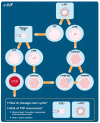Opportunities and Limits of Conventional IVF versus ICSI: It Is Time to Come off the Fence
- PMID: 36233589
- PMCID: PMC9572455
- DOI: 10.3390/jcm11195722
Opportunities and Limits of Conventional IVF versus ICSI: It Is Time to Come off the Fence
Abstract
Conventional IVF (c-IVF) is one of the most practiced assisted reproductive technology (ART) approaches used worldwide. However, in the last years, the number of c-IVF procedures has dropped dramatically in favor of intracytoplasmic sperm injection (ICSI) in cases of non-male-related infertility. In this review, we have outlined advantages and disadvantages associated with c-IVF, highlighting the essential steps governing its success, its limitations, the methodology differences among laboratories and the technical progress. In addition, we have debated recent insights into fundamental questions, including indications regarding maternal age, decreased ovarian reserve, endometriosis, autoimmunity, single oocyte retrieval-cases as well as preimplantation genetic testing cycles. The "overuse" of ICSI procedures in several clinical situations of ART has been critically discussed. These insights will provide a framework for a better understanding of opportunities associated with human c-IVF and for best practice guidelines applicability in the reproductive medicine field.
Keywords: IVF; infertility; reproduction.
Conflict of interest statement
The authors declare no conflict of interest.
Figures
References
-
- European Society of Human Reproduction and Embryology. [(accessed on 25 May 2022)]. Available online: https://www.sciencedaily.com/releases/2018/07/180703084127.htm.


